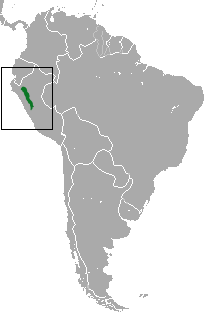Peruvian night monkey
| Peruvian night monkey[1] | |
|---|---|
| | |
| Scientific classification | |
| Kingdom: | Animalia |
| Phylum: | Chordata |
| Class: | Mammalia |
| Order: | Primates |
| Family: | Aotidae |
| Genus: | Aotus |
| Species: | A. miconax |
| Binomial name | |
| Aotus miconax Thomas, 1927 | |
 | |
| Peruvian Night Monkey range | |
The Peruvian night monkey (Aotus miconax), also known as the Andean night monkey, is a nocturnal New World monkey endemic to northern Peru. Adults weigh around 1 kg (2.2 lb) and measure up to 50 cm (20 in) in length. Its colour is grey to light brown with characteristic black and white markings on the face. The chest, belly and upper arms are orange tinged, however, to a lesser extent then Aotus nigriceps.
The species is one of the least known and possibly rarest Neotropical primates. This species is listed as vulnerable by the IUCN and endangered under Peruvian Law.[3]
The Peruvian night monkey is also one of the least studied of all primates. The only data that exists about this species are museum specimens, sighting records and very basic ecological information. The species is thought to inhabit areas of cloud forest at 900–2,800 m (3,000–9,200 ft) above sea level in the departments of Amazonas, Huanuco and San Martin, and in border regions of neighboring departments.[4]
Behavior
The species is monogamous and lives in small family groups of 2 to 6 individuals similar to that of other Aotus species.[5] Hardly any data exists on the dietary requirements of A. miconax, but it is known that it is generally frugivorous but also consumes leaf buds and insects. This species has been observed in primary and secondary forest, from large areas of contiguous forest to small forest patches.
Threats and conservation
The main threat facing the Peruvian night monkey is the continued growth of human populations and associated habitat destruction. Hunting is a lesser threat to this species, but it is still hunted for the pet trade and by trophy hunters.[6]
Neotropical Primate Conservation with funding from Primate Conservation Inc is currently running a conservation based study on the species in La Esperanza, Amazonas. A network of community run reserves is intended to help conserving the species as well as the sympatric, Critically Endangered yellow-tailed woolly monkey.
References
| Wikispecies has information related to: Peruvian Night Monkey |
- ↑ Groves, C.P. (2005). Wilson, D.E.; Reeder, D.M., eds. Mammal Species of the World: A Taxonomic and Geographic Reference (3rd ed.). Baltimore: Johns Hopkins University Press. p. 140. OCLC 62265494. ISBN 0-801-88221-4.
- ↑ Cornejo, F., Rylands, A. B., Mittermeier, R. A. & Heymann, E. (2008). "Aotus miconax". IUCN Red List of Threatened Species. Version 2011.2. International Union for Conservation of Nature. Retrieved 20 January 2012.
- ↑ Heymann EW (2004). "Conservation categories of Peruvian primates – Categorias de conservación de los primates peruanos". Neotropical Primates 12: 154–155. doi:10.1896/1413-4705.12.3.154.
- ↑ Cornejo FM, Aquino R & Jimenez C (2008). "Notes on the natural history, distribution and conservation status of the Andean night monkey, Aotus miconomax Thomas 1927"" (PDF). Primate Conservation 23: 1–4. doi:10.1896/052.023.0101.
- ↑ Fernandez-Duque E (2007). "Aotinae: Social Monogamy in the only Nocturnal Haplorine". In Campbell CJ, Fuentes A, MacKinnon KC, Panger M & Bearder SK. Primates in Perspective. UK: Oxford University press. pp. 139–154.
- ↑ Shanee, N., Shanee S., and Collongues, H. (2008). Local Primate Trade in Amazonas and San Martin, Peru. Poster presented at Primate Society of Great Britain winter meeting 2008.
| ||||||||||||||||||||
